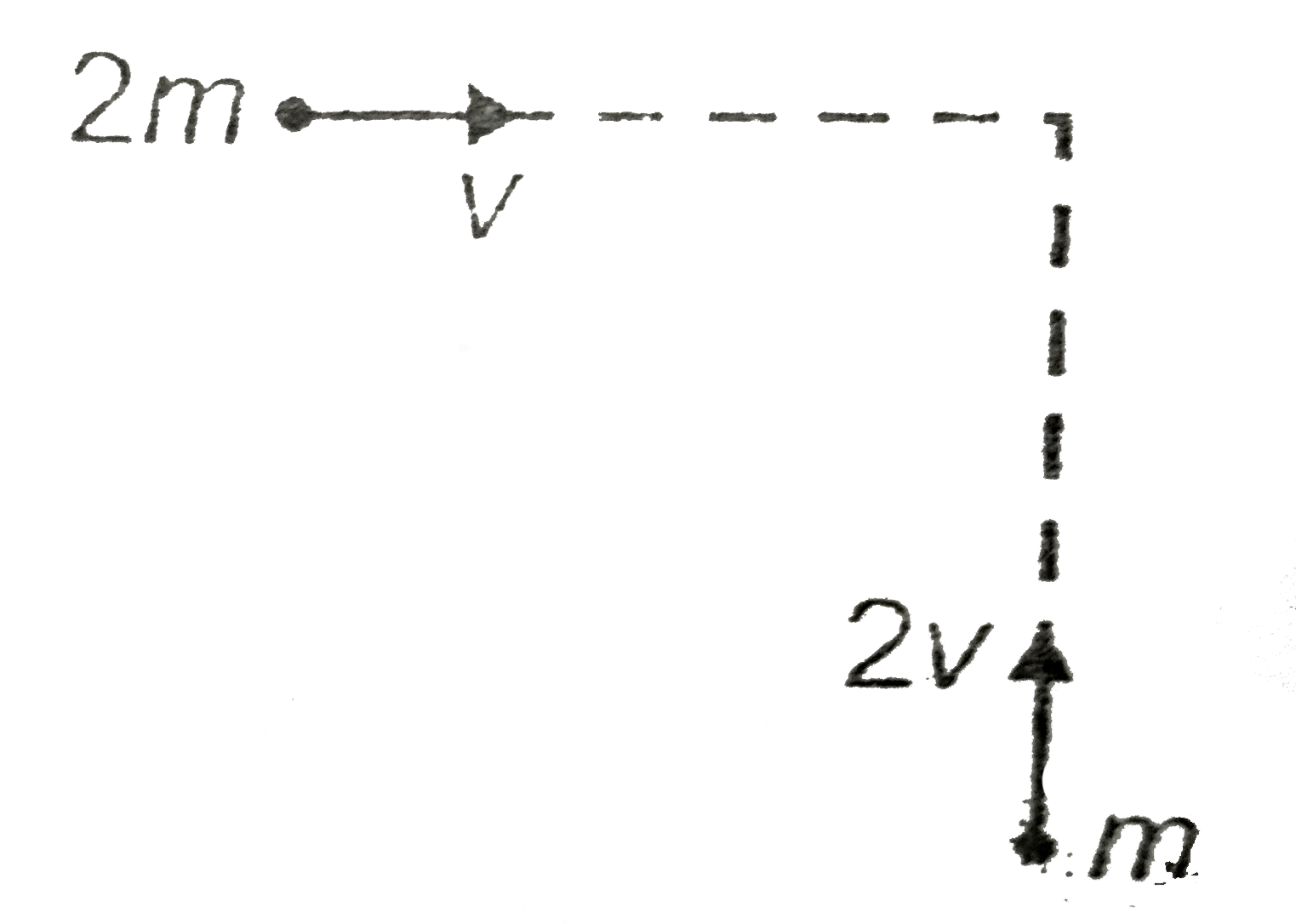Two particles of same mass 'm' moving with velocities →v1=vˆi,and→v2=(v2)ˆi+(v2)ˆjcollide in-elastically. Find the loss in kinetic energy
mv28
5mv28
mv24
3mv28
The correct Answer is:A
To find the loss in kinetic energy during the inelastic collision of two particles with the given velocities, we can follow these steps:
Step 1: Define the velocities of the particles
Let the velocities of the two particles be:
- Particle 1: →v1=v^i
- Particle 2: →v2=v2^i+v2^j
Step 2: Calculate the initial kinetic energy
The initial kinetic energy (KEinitial) of the system is the sum of the kinetic energies of both particles.
KEinitial=12mv21+12mv22
Calculating each term:
- For Particle 1:
KE1=12mv2
- For Particle 2:
KE2=12m(v2)2+12m(v2)2=12m(v24+v24)=12m(v22)=mv24
Thus, the total initial kinetic energy is:
KEinitial=12mv2+mv24=2mv24+mv24=3mv24
Step 3: Determine the final velocity after the collision
In an inelastic collision, the two particles stick together. We can use the conservation of momentum to find the final velocity (→v′) of the combined mass.
The total momentum before the collision is:
→pinitial=m→v1+m→v2=m(v^i)+m(v2^i+v2^j)=mv^i+m(v2^i+v2^j)
=mv^i+mv2^i+mv2^j=(mv+mv2)^i+mv2^j=3mv2^i+mv2^j
The total mass after the collision is 2m. Therefore, the final velocity →v′ is given by:
→v′=→pinitial2m=3mv2^i+mv2^j2m=3v4^i+v4^j
Step 4: Calculate the final kinetic energy
The final kinetic energy (KEfinal) of the combined mass is:
KEfinal=12(2m)(v′)2=m(v′)2
Calculating (v′)2:
(v′)2=(3v4)2+(v4)2=9v216+v216=10v216=5v28
Thus,
KEfinal=m⋅5v28=5mv28
Step 5: Calculate the loss in kinetic energy
The loss in kinetic energy (ΔKE) is given by:
ΔKE=KEinitial−KEfinal
Substituting the values we calculated:
ΔKE=3mv24−5mv28
To subtract these fractions, we need a common denominator (which is 8):
ΔKE=6mv28−5mv28=1mv28
Thus, the loss in kinetic energy is:
ΔKE=mv28
Final Answer
The loss in kinetic energy is mv28.
---
Let the velocities of the two particles be:
- Particle 1: →v1=v^i
- Particle 2: →v2=v2^i+v2^j
The initial kinetic energy (KEinitial) of the system is the sum of the kinetic energies of both particles.
- For Particle 1:
KE1=12mv2
- For Particle 2:
KE2=12m(v2)2+12m(v2)2=12m(v24+v24)=12m(v22)=mv24
KEinitial=12mv2+mv24=2mv24+mv24=3mv24
In an inelastic collision, the two particles stick together. We can use the conservation of momentum to find the final velocity (→v′) of the combined mass.
→pinitial=m→v1+m→v2=m(v^i)+m(v2^i+v2^j)=mv^i+m(v2^i+v2^j)
=mv^i+mv2^i+mv2^j=(mv+mv2)^i+mv2^j=3mv2^i+mv2^j
→v′=→pinitial2m=3mv2^i+mv2^j2m=3v4^i+v4^j
The final kinetic energy (KEfinal) of the combined mass is:
KEfinal=12(2m)(v′)2=m(v′)2
Calculating (v′)2:
(v′)2=(3v4)2+(v4)2=9v216+v216=10v216=5v28
Thus,
KEfinal=m⋅5v28=5mv28
The loss in kinetic energy (ΔKE) is given by:
ΔKE=KEinitial−KEfinal
Substituting the values we calculated:
ΔKE=3mv24−5mv28
To subtract these fractions, we need a common denominator (which is 8):
ΔKE=6mv28−5mv28=1mv28
ΔKE=mv28
The loss in kinetic energy is mv28.
Topper's Solved these Questions
Similar Questions
Two particles of mass m & 2m have velocities uˆj & uˆi respectively . They collide completely inelastically. Find the loss in kinetic energy of the system.
View SolutionTwo particles of mass m & 2m have velocities uˆj & uˆi respectively . They collide completely inelastically. Find the loss in kinetic energy of the system.
View Solution
Knowledge Check
- Question 1 - Select One
A particle of mass 1 g moving with a velocity →v1=3ˆi−2ˆjms−1 experiences a perfectly in elastic collision with another particle of mass 2 g and velocity →v2=4ˆj−6ˆkms−1. The velocity of the particle is
A2.3ms−1B4.6ms−1C9.2ms−1D6ms−1
Two particles of same mass m moving with velocities u1 and u2 collide perfectly inelastically. The loss of energy would be :
View SolutionTwo particles of equal mass m are moving with velocities vˆi and v(ˆi+ˆj2) respectively. If the particles collide completely inelastically, then the energy lost in the process is
View SolutionTwo particles of mass 2m and m moving with speed v and 2v respectively pependicular to each other collides perfectly inelastically, then

Find the angle with the horizontal to which the particles move after collision.View SolutionA particle of mass m1 moving with velocity v in a positive direction collides elastically with a mass m2 moving in opposite direction also at velocity v. If m2>>m1, then
View SolutionA particle of mass m moving with speed u collides perfectly inelastically with another particle of mass 2m at rest. Find loss of kinetic energy of system in the collision.
View SolutionA particle of mass m moving with speed u collides perfectly inelastically with another particle of mass 2m at rest. Find loss of kinetic energy of system in the collision.
View SolutionTwo particles having position verctors →r1=(3ˆi+5ˆj) metres and →r2=(−5ˆi−3ˆj) metres are moving with velocities →v1=(4ˆi+3ˆj)m/sand→v2=(αˆi+7ˆj)m/s. If they collide after 2 seconds, the value of α is
View Solution

